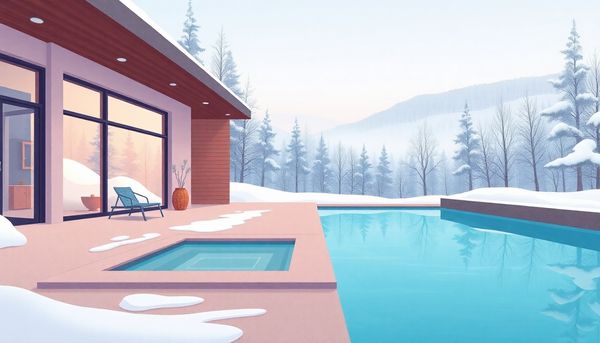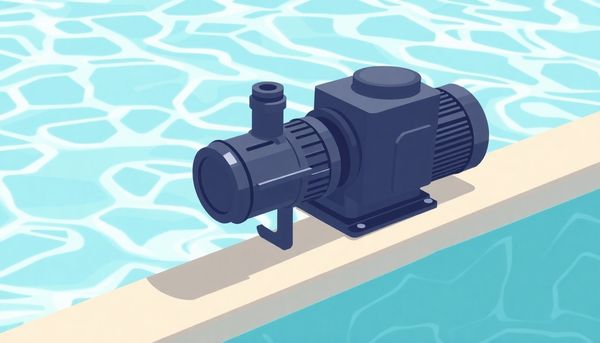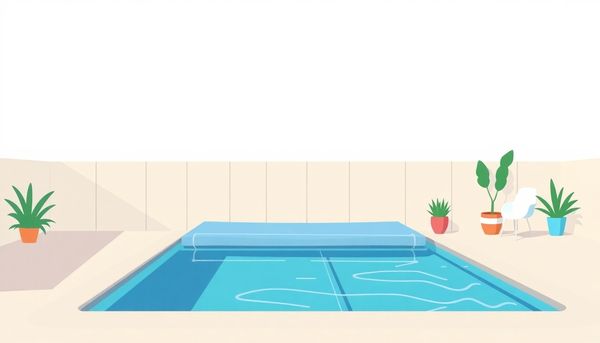12 Cost-Saving Tips for Affordable Pool Maintenance
July 30th, 2024
July 30th, 2024
Owning a swimming pool can feel like a luxurious dream come true, offering a personal oasis right in your backyard. However, the reality of maintaining such an indulgence often presents financial hurdles that can leave many pool owners afloat in unexpected costs. My neighbor once lamented how his utility bills skyrocketed during the summer months, almost making him regret his decision until he discovered a few clever tricks to keep expenses under control.
Firsthand experiences like his remind us that enjoying a pool doesn't have to break the bank. Whether you’re a new pool owner or a seasoned swimmer, making a few strategic adjustments can lead to substantial savings. It's not just about reducing water usage; it’s about understanding the nuances of energy efficiency, chemical balance, and routine maintenance.
From optimizing your pool’s pump schedule to exploring solar heating solutions, there are countless ways to cut costs without sacrificing enjoyment. By incorporating these tips, not only can you save money, but you’ll also contribute positively to environmental stewardship. Every adjustment, no matter how small, adds up over time. So, if you're ready to keep both your pool and your wallet in pristine condition, these insights could prove invaluable. Dive into this guide to discover twelve practical strategies that pool owners can implement for a more cost-effective and environmentally friendly swimming experience.

The pool vacuum head may not be the most glamorous piece of equipment, but it silently bears the brunt of keeping your pool pristine. Often overlooked, its demise is typically due to the wear of its bottom brushes—flattened from years of use or lost to neglect. But there’s a simple secret to extending its life, which can save you from frequent replacements.
During the months when your pool is just a fond memory, store your vacuum head upside down and away from the sun's harsh rays. This tactic prevents the stiff bristles from being crushed under their own weight. Sunlight, especially in warmer climates, can cause the plastic components to become brittle over time, turning an otherwise sturdy vacuum head into a fragile relic. Winter months add their own challenge. Chlorine, though crucial for pool maintenance, can degrade your vacuum head if stored nearby. I learned this the hard way—a costly lesson that I now share with anyone willing to listen.
The design of most vacuum heads is such that they can gracefully glide over your pool’s contours, embracing both concrete and fiberglass surfaces without causing damage. These features are handy, but only if the vacuum is cared for properly. By taking a few simple precautions, you can ensure that your vacuum head remains as functional as the day you bought it, allowing you to allocate your budget to more exciting poolside endeavors.
Storing pool equipment correctly might seem like a small detail, but it can lead to substantial savings over time. Consider the vacuum head, an essential tool that often requires replacement because of improper storage. The brushes underneath are prone to damage from sunlight and chlorine exposure. By simply storing the vacuum head upside down and away from harsh conditions during the off-season, you can easily double its lifespan. This small step avoids frequent replacements, keeping more money in your wallet.
When it comes to pool chemicals, similar principles apply. Carefully storing chemicals in a cool, dry place not only preserves their efficacy but also ensures you aren't spending extra on replacements. Investing in a few sturdy, labeled bins can help prevent accidental spills or contamination, maintaining the potency of your chemicals throughout the swimming season.
Let's also talk about your pool cover. Keeping it clean and dry while in storage prevents mold and mildew, which can degrade the material over time. A well-maintained cover lasts longer, saving you from the annual expense of buying a new one. Consider rolling it tightly and securing it with straps before storing it in a dry area, away from direct sunlight.
These simple yet effective storage strategies can significantly extend the life of your pool equipment and supplies, reducing unnecessary expenses and allowing you to enjoy your pool without breaking the bank.
Safeguarding your pool brushes might not seem like a pressing concern, but neglecting them can lead to frequent replacements and unnecessary expenses. A few simple habits can prolong the life of these essential tools, saving you both time and money.
When you're finished using your pool brushes, make sure they’re stored properly to prevent damage. After cleaning, shake off excess water and allow them to dry completely before putting them away. Moisture can weaken bristles and lead to mildew, reducing their effectiveness over time. It’s similar to leaving a toothbrush damp—it just doesn’t last as long.
Sunlight can also be a hidden enemy. Keep your brushes out of direct sunlight when not in use, as UV rays can cause the bristles to become brittle and break. Consider a shaded storage area or a container to help protect them from the elements. In my own experience, I found that stashing them in the garage during off-season months kept them in great shape for years.
Furthermore, if you've got a habit of cleaning your pool with aggressive chemicals, rinse the brushes thoroughly after each use. This prevents chemical residue from lingering, which can corrode and degrade the brush material over time.
By taking these simple steps, you'll extend the life of your pool brushes significantly, cutting down on replacement costs and ensuring that your pool remains pristine with minimal fuss.
Imagine your pool equipment basking in the sun, day after day, slowly deteriorating under its relentless rays. One might think that these tools, built to withstand pool chemicals and water, are invincible to sunlight. Yet, the sun is one of their silent adversaries. Stashing your pool gear, like the vacuum head, away from direct sunlight extends its life significantly. By storing it upside down, away from the harsh UV exposure, those brushes remain springy and effective far longer. This simple act of shade can prevent premature wear, saving you the expense of a replacement.
Similarly, chlorine's presence is essential for pool cleanliness, but overexposure can be corrosive to your equipment. During the cooler months, take the extra step to store your tools well away from chlorine's reach. It might sound trivial, but neglecting this can lead to brittleness and breakdown over time. My neighbor learned this the hard way, finding his vacuum head bristles crisp as autumn leaves one spring. The cost of replacement was a harsh lesson in the importance of proper storage.
Consider these small adjustments as investments in your pool's future. By guarding your equipment against sun and chlorine, you avoid unnecessary costs, ensuring your tools last season after season. This simple foresight adds up to substantial savings over the years, leaving more in your pocket for poolside fun.

As the chill of winter approaches, prepping your pool for hibernation can save both time and money when spring rolls around. Begin by giving your pool a thorough cleaning; vacuuming and brushing the walls removes debris that could cause stains or algae blooms while it’s out of use. Then, balance the water chemistry. Proper pH, alkalinity, and calcium hardness levels act as a protective shield against damage during the cold months.
Invest in a quality winterizing chemical kit. These kits usually come with everything needed: a powerful algaecide, stain preventers, and a chlorine-free shock. You might be tempted to skip this step, but these chemicals help maintain the water quality and prevent costly damage to pool surfaces and equipment.
Covering your pool is crucial. A solid, well-fitted cover keeps debris out and prevents water evaporation, saving you both cleanup time and water costs. Consider using a cover pump to remove rain or snow, which can weigh down and damage the cover. It’s an investment that pays off by extending the cover’s lifespan.
Finally, store your pool equipment properly. Drain and clean filters, store hoses and vacuums away from sunlight, and keep them dry to prevent mold growth. This kind of diligence ensures your gear is in top condition when you’re ready to dive back in. By winterizing efficiently, you're not just preparing for the cold, but setting up for a smooth, cost-effective swim season when the sun returns.
Every pool owner knows that behind the serene surface lies a labyrinth of equipment working tirelessly to ensure your aquatic oasis remains pristine. Protecting this equipment is crucial, not just for consistent pool enjoyment but also to stave off hefty replacements. One of the easiest yet often overlooked steps is the care of your vacuum head. It's common to find the brushes worn down, a simple consequence of sun exposure and inadvertent chlorine contact. By storing the vacuum head upside down and away from both sunlight and harsh chemicals during off-seasons, you could effectively double its lifespan.
Beyond the vacuum, other components like the pump and heater demand attention. Regular maintenance checks can make a world of difference. For instance, ensuring your pump's filter is clean reduces strain on the motor, enhancing efficiency and prolonging its life. My neighbor once neglected his filter, and a replacement pump cost him a small fortune. Avoid such pitfalls by scheduling routine inspections.
Another savvy move is investing in a pool cover. Not only does it shield your pool from debris but also protects the expensive heating equipment from overuse as it retains warmth. Should winterizing your pool feel daunting, pre-packaged chemical kits simplify the process, safeguarding both equipment and water quality. By taking these steps, you not only preserve your pool equipment but also keep more money in your pocket.
Mastering the art of pool water conservation is not just an eco-friendly choice but a smart financial move as well. Consider the tapestry of strategies available to maintain your aquatic oasis while minimizing waste.
First, let the evaporation thief know it's unwelcome. A solar cover acts as a guardian, significantly reducing water loss by trapping moisture and warmth. This simple investment prevents the alarming 25,000 gallons of annual evaporation some pools face, particularly in arid climates. Beyond covering, think strategically about landscaping. Trees and shrubs do more than beautify; they shield against wind, a notorious evaporation enhancer.
Next, channel your inner detective to spot leaks. A grease pencil and a vigilant eye can reveal telltale signs of water seeping away. If there's suspicion of a leak, a dye tester can pinpoint the exact location, placing you one step closer to a fix. Addressing leaks promptly not only conserves water but can prevent more costly repairs down the road.
Finally, be mindful of splash. While enthusiasm is part of pool fun, moderating excessive water play can save gallons over a season. Consider adjusting water features like fountains and waterfalls to reduce unnecessary splashing when they're not in use.
By incorporating these habits into your pool maintenance routine, you not only champion water conservation but also keep your wallet afloat, ensuring every swim is as rewarding as the last.
As the chill of winter approaches, the importance of a smart winter-cover strategy for your pool becomes paramount. A well-thought-out approach not only shields your pool from harsh weather but also saves a bundle on maintenance come spring. One friend of mine, learning from experience, discovered the magic of investing in a quality winter cover. She opted for a durable, UV-resistant cover that not only kept out debris but also minimized water evaporation, cutting down her water bill significantly.
Consider the benefits of regular upkeep. Removing accumulated water and debris from the cover with a pool cover pump ensures it remains in good condition. This small effort goes a long way in preventing damage to the cover itself, which can be costly to replace. Another friend swears by using an inexpensive leaf net over her primary cover, making leaf removal a breeze and extending the cover’s lifespan.
Furthermore, proper fit is key. A snug cover prevents wind from sneaking beneath and causing damage—a lesson learned the hard way by many pool owners. Tightly securing the cover reduces the risk of tears and ensures that your investment lasts several seasons. By taking these proactive steps, you not only protect your pool but also keep your wallet happy, avoiding the expense and hassle of premature cover replacement. Embrace these smart practices, and next spring, you’ll be ready to enjoy your pool without the added stress and costs of winter damage.

A bright blue pool shimmering under the sun can be a delight, but managing the costs? That’s where strategic use of solar covers comes in. Solar covers, those unassuming sheets floating on the water, can be a pool owner’s best friend. They not only help retain heat but significantly reduce water and chemical evaporation. By trapping the sun's warmth during the day and keeping the chill at bay at night, a solar cover can raise pool temperatures by up to 15 degrees Fahrenheit. This means less reliance on expensive pool heaters, translating to substantial savings on your energy bills.
Consider the scenario of an evening swim without a solar cover. The warmth from the day slips away easily, leaving the pool cooler than desired. In contrast, diligent use of a solar cover maintains the temperature, ensuring a welcoming dip at any hour. Also, these covers act as a barrier against debris, reducing the need for frequent clean-ups and saving on chemical costs.
For those who find the nightly ritual of covering and uncovering the pool a hassle, liquid solar covers could be a game changer. Simply pour a small amount into the water, and it forms an invisible barrier that mimics the heat-trapping benefits of traditional covers. While less effective, it provides convenience and still cuts costs.
Using solar covers wisely not only preserves warmth but also guards against unnecessary expenditure, allowing you to enjoy endless hours of swimming without financial worries.
Warm waters on a cool evening—the perfect poolside retreat. A pivotal factor for pool lovers is retaining that inviting warmth without soaring energy bills. The secret? Maximizing heat retention. This isn't just about comfort; it's about smart, sustainable pool management.
Consider utilizing a solar cover, which acts like a giant, snug blanket for your pool. During one particularly chilly summer, a friend discovered that her pool stayed several degrees warmer simply by using a solar blanket overnight. It traps the day's heat, reduces evaporation, and even keeps debris at bay. If wrestling with covers isn't your style, liquid solar covers offer a hassle-free alternative. A simple pour creates an invisible barrier, preserving heat discreetly.
Also, think about the placement of windbreaks around your pool. On breezy afternoons, wind can whisk away warmth quicker than you'd expect. Constructing a barrier with shrubs or fences around the pool area not only reduces heat loss but adds an aesthetic charm.
Finally, timing matters. Running your pool heater during off-peak hours can be a game-changer for your utility bill. Crank up the heat slightly when energy costs are lower and rely on the cover to maintain it during the high-rate periods.
By combining these strategies, you’ll not only keep your pool cozy, but you’ll also ease the strain on your wallet. Isn’t it wonderful when comfort aligns with cost-efficiency?
Evaporation may be invisible, but its impact on your pool’s water levels—and your wallet—is undeniable. During a hot summer in Texas, I noticed my pool's water line dropping more quickly than usual. It wasn’t leaks or excessive splashing; it was the sun’s relentless rays. This gradual loss can cause your pool to guzzle thousands of gallons annually, quietly increasing your water bill.
A solar cover became my first line of defense. While initially skeptical, I found it incredibly effective. Simply covering the pool when it wasn’t in use significantly reduced water loss. More than just a dust shield, it traps heat and diminishes evaporation, saving both water and energy costs. If you’re not keen on wrestling a bulky cover, liquid solar covers offer a hassle-free alternative.
Another trick up my sleeve involved landscaping. Planting tall shrubs and installing a fence around the perimeter helped to break up wind patterns that otherwise whisk away water molecules from the pool’s surface. You’d be surprised at how a gentle breeze can accelerate evaporation.
Finally, if you have a pool heater, keep it at a moderate temperature. High heat encourages evaporation, undoing all other conservation efforts. With these strategies, you can enjoy your pool without watching your water—and money—vanish into thin air.
In the world of pool maintenance, innovation often comes from unexpected quarters. Liquid solar covers are one such modern marvel. Unlike their traditional counterparts, these covers don't require the cumbersome task of rolling out a large, unwieldy blanket over your pool. Instead, they offer a slick, invisible barrier that floats atop the water's surface, significantly reducing evaporation.
My friend Tom once raved about his switch to liquid solar covers. Living in Arizona, where the sun's relentless rays seemed to drink up pool water faster than a thirsty marathon runner, Tom faced a constant battle with water loss. Tired of dragging a heavy cover on and off his pool, he gave liquid solar covers a shot. Tom couldn't have been happier with the results. Not only did he notice a marked decrease in water evaporation, but he also enjoyed a subtle increase in water temperature, akin to being wrapped in a warm embrace.
These liquid solutions are not only user-friendly but also cost-effective. Simply pour them into the pool, and they form a thin layer that performs the dual duty of heat retention and water conservation. As a bonus, they can integrate seamlessly with your existing maintenance routine without adding extra chores. For those looking to save money and effort on pool upkeep, liquid solar covers present an appealing, hassle-free option.

Among the many components that keep your pool sparkling, the pump quietly performs its crucial role, yet often gets overlooked when it comes to cost-saving strategies. My neighbor, who loves her backyard oasis, once discovered this secret to slashing her energy bills: optimizing her pool pump. Many pool owners still run their pumps at full throttle, unaware of the potential savings that lie in timing and technology.
A simple but effective adjustment is to shift the pump’s operation to off-peak hours. Most electric companies charge less at night or early morning, so by running your pump during these times, you can lighten your energy bill. My friend adopted this approach and noticed a significant dip in her electricity costs over the summer months. Additionally, consider reducing the runtime of your pump. Unless you’re combating high temperatures or heavy usage, most pools don’t need their pumps running around the clock.
For those in the market for a more advanced solution, a variable-speed pump presents an appealing option. Unlike single-speed pumps, these allow you to adjust the flow rate according to your pool's needs, providing efficiency and significant savings. Although initially more expensive, variable-speed pumps often pay for themselves within a few seasons through reduced energy consumption. Embrace these strategies, and your pump can transform from an energy guzzler into a cost-efficient ally.
When it comes to your pool, slashing costs doesn't have to mean sacrificing comfort. Incorporating energy-saving techniques can significantly reduce your expenses while still enjoying a sparkling oasis. Start with the heart of your pool's circulation system: the pump. Switching to a variable-speed pool pump can be a game changer. Unlike traditional single-speed pumps, a variable-speed pump only uses the energy necessary for the task at hand, potentially saving up to 70% on electricity bills.
Consider also the power of the sun. Installing a solar pool heater can extend your swimming season without breaking the bank. While the upfront cost may be higher compared to conventional heaters, the sun provides a free and endless supply of energy, meaning your long-term savings will outweigh the initial investment. Pair this with a well-fitted solar cover, which traps heat and minimizes evaporation, and you’ll notice a significant drop in heating costs.
Additionally, LED lighting can replace traditional pool lights. Not only do LEDs consume less electricity, but they also have a longer lifespan, reducing the frequency and hassle of replacements. As you lounge poolside, the glow from your efficient LEDs will reflect not just off the water, but also in your reduced energy bills. By embracing these techniques, you ensure your pool remains a place of relaxation and enjoyment, all while keeping your wallet happy.
Prolonging the life of your pool equipment isn't just about saving a few bucks—it's about peace of mind and uninterrupted swimming fun. You know that feeling when everything just works? Let's keep it that way with some savvy maintenance strategies.
Firstly, let's talk storage. After a season of skimming and cleaning, your vacuum head deserves a break from the harsh sun and chlorine-laden environments. By simply storing it upside down in a shaded spot, you're protecting those precious brushes from flattening or falling off—a common reason for premature replacement.
When it comes to winterizing, consider this an investment in the longevity of your pool's components. Learning to winterize your above-ground pool isn't as daunting as it sounds. A well-stored pool kit, complete with winter algaecide and stain prevention tools, can stave off seasonal wear and tear.
Next, protect your pool heater and other sensitive equipment from the elements. A reliable pool heater that boasts a cupro nickel heat exchanger can stand the test of time against corrosive water chemistry. But it's still wise to cover it during the off-season or periods of non-use.
Finally, don't underestimate the power of a regular cleaning routine. Keep filters and pumps in optimal condition by adhering to a strict maintenance schedule. This not only enhances efficiency but also reduces the need for costly repairs or replacements.
By embracing these practices, you're not just extending the life of your equipment—you're ensuring countless summers of stress-free swimming enjoyment.
Water is a precious resource, and with a pool, it can easily slip through your fingers—often unnoticed until the bill arrives. To conserve water effectively, a few mindful habits can go a long way in preserving both nature and your wallet.
Evaporation is the unseen thief, quietly sapping away gallons when you're not looking. Covering your pool with a solar blanket not only saves water but also keeps it warmer, reducing heating costs. I remember my neighbor lamenting about his skyrocketing water bills until he started using a simple cover; suddenly, his pool maintenance seemed much less daunting.
Splashing is part of the fun, no doubt, but excessive splashing can lead to noticeable water loss. Encouraging games that don’t involve a lot of splashing can help. Think of it as a win-win—still fun, but less water wasted.
Leaks are another sneaky culprit. Checking for leaks doesn’t require a pool expert. A simple grease pencil line at the skimmer level can reveal overnight water loss. Finding a leak early means a quick patch job rather than a costly refill. My cousin once let a leak linger until the water levels were tragically low, only to find the fix was just a cheap patch away.
Lastly, backwashing is essential for clean water, but overdoing it wastes gallons. Keep an eye on your filter’s pressure gauge and backwash only when needed. This habit alone can save hundreds of gallons each season. With these strategies, your pool can be an oasis of savings, both financial and environmental.

Water conservation isn't just an environmental buzzword; for pool owners, it's a pathway to significant savings. A clever solution to this is the use of smart covers. These modern marvels not only cut down on water loss but also reduce your utility bills, keeping more cash in your pocket.
Take my friend Sarah, for instance. She lives in Arizona, where the sun seems relentless year-round. Her traditional pool cover was a hassle, often left unused because of the cumbersome process of putting it on and off. After switching to a smart cover, she noticed an immediate difference. This cover, lightweight and easy to manage, effectively reduced water evaporation and maintained the temperature of her pool. Sarah reported saving nearly 30% on her water bill over just a few months.
Smart covers are designed to fit snugly over your pool, acting like a seal against the elements. They minimize heat loss, meaning that your heater works less, saving energy. Plus, they serve as a barrier to debris, reducing the workload on your filtration system.
On windy days, these covers shine even brighter. They prevent water from evaporating due to wind exposure, a common culprit in regions with varied climates. Investing in a smart cover means preserving your pool’s water, prolonging the life of your equipment, and ultimately, saving money. It's a small upfront cost for a significant, long-term benefit.
Caring for a swimming pool is much like tending to a garden—it requires regular attention and a bit of know-how. A well-maintained pool not only extends the life of your equipment but also keeps your wallet happy by preventing unnecessary repairs. Start with your pool's filtration system. Clean the filter regularly to ensure it operates efficiently; a clogged filter makes the pump work harder, leading to higher energy consumption and potential damage.
Consider investing in a pool cover. Not only does this simple tool reduce evaporation, saving water, but it also keeps debris out, which means less cleaning and fewer chemicals needed. A friend once shared how a solar cover reduced their heating costs by capturing the sun’s warmth, maintaining a comfortable temperature without extra energy.
Regularly check the water chemistry. It might sound daunting, but keeping the pH, alkalinity, and chlorine levels balanced can prevent corrosion of pool surfaces and equipment. Test kits are readily available and easy to use, providing peace of mind and sparing you from costly chemical imbalances.
Lastly, address any leaks promptly. A small leak can waste thousands of gallons over time, inflating your water bills. Conduct a simple bucket test if you suspect a leak—place a bucket on a step, fill it to the same level as the pool, and compare water levels after 24 hours.
These practices, simple yet effective, ensure a healthier pool and a happier bank account.
The sun beats down, casting its warm rays across your shimmering pool. While this might be perfect for a lazy summer afternoon, it also signals an age-old adversary: evaporation. Without even realizing it, your pool can lose several inches of water weekly, especially in hot, dry climates. This not only wastes water but also leads to frequent top-ups, escalating your water bill.
To curb this sneaky drain on resources, consider investing in a solar cover. This simple tool acts as a barrier, preserving both warmth and water. Think of it as a cozy blanket that not only keeps your pool cozy but also shields it from debris, minimizing cleaning efforts. When not taking a dip, ensure the cover is snugly in place, especially during windy days, as wind significantly accelerates water loss.
Moreover, your pool's environment plays a role. By planting windbreaks such as shrubs or installing fences, you can create a natural shield against gusts that whisk water away. A pool heater set to a moderate temperature also helps maintain water levels; the less heat you need, the less evaporation occurs.
Finally, regular pool checks for leaks can save you from unforeseen losses. A minor leak might seem negligible but can lead to substantial water waste over time. By taking these steps, you not only conserve precious resources but also create a more efficient and cost-effective swimming haven.

This article provided insights into maintaining your pool. Start your pool care journey today!
Want to become a pool maintenance expert? Our free Pool School course covers everything you need to know about pool care. From basic maintenance to advanced troubleshooting, you'll learn how to:
Join over 10,000 pool owners who have already transformed their pool care routine. Get started with our free Pool School course today!